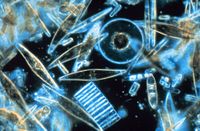
A flagellate is a cell or organism with one or more whip-like appendages called flagella. The word flagellate also describes a particular construction characteristic of many prokaryotes and eukaryotes and their means of motion. The term presently does not imply any specific relationship or classification of the organisms that possess flagella. However, the term "flagellate" is included in other terms which are more formally characterized.

A diatom is any member of a large group comprising several genera of algae, specifically microalgae, found in the oceans, waterways and soils of the world. Living diatoms make up a significant portion of the Earth's biomass: they generate about 20 to 50 percent of the oxygen produced on the planet each year, take in over 6.7 billion tonnes of silicon each year from the waters in which they live, and constitute nearly half of the organic material found in the oceans. The shells of dead diatoms can reach as much as a half-mile deep on the ocean floor, and the entire Amazon basin is fertilized annually by 27 million tons of diatom shell dust transported by transatlantic winds from the African Sahara, much of it from the Bodélé Depression, which was once made up of a system of fresh-water lakes.

Brown algae are a large group of multicellular algae comprising the class Phaeophyceae. They include many seaweeds located in colder waters of the Northern Hemisphere. Brown algae are the major seaweeds of the temperate and polar regions. Many brown algae, such as members of the order Fucales, commonly grow along rocky seashores. Most brown algae live in marine environments, where they play an important role both as food and as a potential habitat. For instance, Macrocystis, a kelp of the order Laminariales, may reach 60 m (200 ft) in length and forms prominent underwater kelp forests that contain a high level of biodiversity. Another example is Sargassum, which creates unique floating mats of seaweed in the tropical waters of the Sargasso Sea that serve as the habitats for many species. Some members of the class, such as kelps, are used by humans as food.

In biology, a biological life cycle is a series of stages of the life of an organism, that begins as a zygote, often in an egg, and concludes as an adult that reproduces, producing an offspring in the form of a new zygote which then itself goes through the same series of stages, the process repeating in a cyclic fashion.
A resting spore is a resistant cell, used to survive adverse environmental conditions. Resting spore is a term commonly applied to both diatoms and fungi.

Tabellaria is a genus of freshwater diatoms. They are cuboid in shape, and the frustules are attached at the corners so that the colonies assume a zigzag shape.
In botany, a zoid or zoïd is a reproductive cell that possesses one or more flagella, and is capable of independent movement. Zoid can refer to either an asexually reproductive spore or a sexually reproductive gamete. In sexually reproductive gametes, zoids can be either male or female depending on the species. For example, some brown alga (Phaeophyceae) reproduce by producing multi-flagellated male and female gametes that recombine to form the diploid sporangia. Zoids are primarily found in some protists, diatoms, green alga, brown alga, non-vascular plants, and a few vascular plants. The most common classification group that produces zoids is the heterokonts or stramenopiles. These include green alga, brown alga, oomycetes, and some protists. The term is generally not used to describe motile, flagellated sperm found in animals. Zoid is also commonly confused for zooid which is a single organism that is part of a colonial animal.

The Coscinodiscophyceae are a class(s) of diatoms. They are similar to the Centrales, a traditional, paraphyletic subdivision of the heterokont algae known as diatoms. The order is named for the shape of the cell walls of centric diatoms, which are circular or ellipsoid in valve view. The valves often bear radially symmetrical ornamental patterns that can appear as dots when viewed with an optical microscope. Some also bear spines on their valves, which may either increase cell surface area and reduce sinking, or act as a deterrent to zooplankton grazers. Unlike pennate diatoms, centric diatoms never have a raphe.
Auxospores are specialised cells in diatoms that are produced at key stages in their cell cycle or life history. Auxospores typically play a role in growth processes, sexual reproduction or dormancy.
Multinucleate cells are eukaryotic cells that have more than one nucleus per cell, i.e., multiple nuclei share one common cytoplasm. Mitosis in multinucleate cells can occur either in a coordinated, synchronous manner where all nuclei divide simultaneously or asynchronously where individual nuclei divide independently in time and space. Certain organisms may have a multinuclear stage of their life cycle. For example, slime molds have a vegetative, multinucleate life stage called a plasmodium.

Ochrophytes, also known as heterokontophytes or stramenochromes, are a group of algae. They are the photosynthetic stramenopiles, a group of eukaryotes, organisms with a cell nucleus, characterized by the presence of two unequal flagella, one of which has tripartite hairs called mastigonemes. In particular, they are characterized by photosynthetic organelles or plastids enclosed by four membranes, with membrane-bound compartments called thylakoids organized in piles of three, chlorophyll a and c as their photosynthetic pigments, and additional pigments such as β-carotene and xanthophylls. Ochrophytes are one of the most diverse lineages of eukaryotes, containing ecologically important algae such as brown algae and diatoms. They are classified either as phylum Ochrophyta or Heterokontophyta, or as subphylum Ochrophytina within phylum Gyrista. Their plastids are of red algal origin.
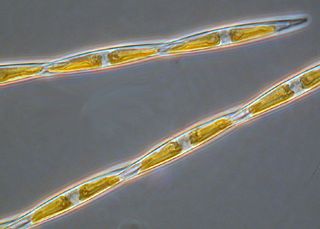
Pseudo-nitzschia is a marine planktonic diatom genus that accounts for 4.4% of pennate diatoms found worldwide. Some species are capable of producing the neurotoxin domoic acid (DA), which is responsible for the neurological disorder in humans known as amnesic shellfish poisoning (ASP). Currently, 58 species are known, 28 of which have been shown to produce DA. It was originally hypothesized that only dinoflagellates could produce harmful algal toxins, but a deadly bloom of Pseudo-nitzschia occurred in 1987 in the bays of Prince Edward Island, Canada, and led to an outbreak of ASP. Over 100 people were affected by this outbreak after consuming contaminated mussels; three people died. Since this event, no additional deaths have been attributed to ASP, though the prevalence of toxic diatoms and DA has increased worldwide. This anomaly is likely due to increased awareness of harmful algal blooms (HABs) and their implications for human and ecosystem health.

Bacillaria is a diatom genus in the family Bacillariaceae.

Ditylum brightwellii is a species of cosmopolitan marine centric diatoms. It is a unicellular photosynthetic autotroph that has the ability to divide rapidly and contribute to spring phytoplankton blooms.

Autospores are a type of spores that are produced by algae to enable asexual reproduction and spread. They are non-motile and non-flagellated aplanospores that are generated within a parent cell and have the same shape as the parent cell before their release. Autospores are also known as resting spores. Algae primarily use three different types of spores for asexual reproduction - autospores, zoospores, and aplanospores. Autospores occur in several groups of algae, including Eustigmatophyceae, Dinoflagellates, and green algae. One example of a colonial alga that produces autospores is Dichotomococcus. This alga generates two autospores per reproducing cell, and the autospores escape through a slit in the cell wall and remain attached to the mother cell. Some study on autospores and algae in general include looking into its use for biofuel, animal feed, food supplements, nutraceuticals, and pharmaceuticals.
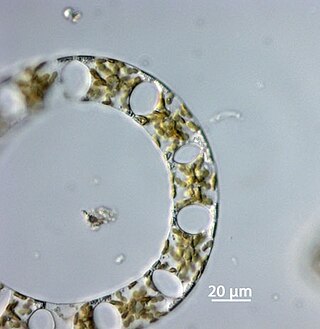
Eucampia zodiacus is a common marine centric diatom species. It is known to be cosmopolitan except in polar regions. E. zodiacus is a harmful diatom that has become known as the predominant organisms causing the bleaching of aqua-cultured nori seaweed.
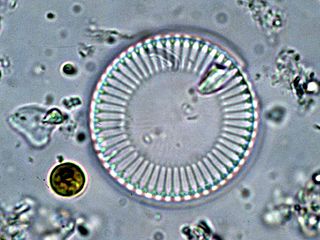
Cyclotella is a genus of diatoms often found in oligotrophic environments, both marine and fresh water. It is in the family Stephanodiscaceae and the order Thalassiosirales. The genus was first discovered in the mid-1800s and since then has become an umbrella genus for nearly 100 different species, the most well-studied and the best known being Cyclotella meneghiniana. Despite being among the most dominant genera in low-productivity environments, it is relatively understudied.

Diatoms belong to a large group called the heterokonts, which include both autotrophs such as golden algae and kelp; and heterotrophs such as water moulds. The classification of heterokonts is still unsettled: they may be designated a division, phylum, kingdom, or something intermediate to those. Consequently, diatoms are ranked anywhere from a class, usually called Diatomophyceae or Bacillariophyceae, to a division (=phylum), usually called Bacillariophyta, with corresponding changes in the ranks of their subgroups.
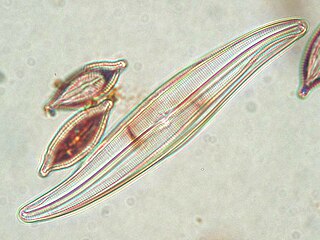
Gyrosigma is a genus of diatoms belonging to the family Pleurosigmataceae.

Phycophthorum is a monotypic genus of protists that parasitize diatoms, containing the sole species Phycophthorum isakeiti. It was discovered in 2020 in the coastal waters of Norway, as parasites of diatoms belonging to the genus Pleurosigma.
